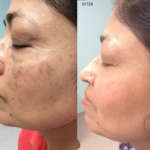Age & Brown Spots Removal
Sun spots, sun freckles, or age spots, known medically as solar lentigo (plural lentigines) are small dark marks on your skin on sun exposed areas. Sun spots are also known as “liver spots” which is a misnomer as the spots are not related to liver disease. They vary in size and shape and usually appear on the head and neck area, hands, shoulders, arms, and lower legs. These are all exposed areas of the body and receive the most ultraviolet rays from sun exposure. Sun spots are common in adults of all ages but especially more prevalent after the age of 40. However, younger individuals can get them too, especially if there is a history of sun exposure or tanning bed/salon usage. Sun spots can look like cancerous growths. However, true sun spots are harmless and do not need further medical treatment.
For cosmetic reasons, sun spots and age spots (benign keratosis) can be easily removed using a variety of methods including our latest and state of the art laser systems including the Pico technology and Nanosecond Nd:YAG lasers. Schedule a consultation with our staff to develop a laser treatment plan that is right for you!
You can help prevent sun spots by regularly using sunscreen with SPF 50 or greater (reapplying it every 2 hours while outside) and avoiding the sun when possible.
Sun spots may affect people of all skin types but they’re more common in individuals with lighter skin types. Sun spots:
- Are flat, oval areas of increased pigmentation.
- Are usually tan, brown or black.
- Occur on skin that has had the most sun exposure over the years (head and neck, hands and feet, chest and upper back).
- Range from freckle size to roughly the size of a quarter across and can group together making them more noticeable.
Sun spots are usually harmless and do not require any further care. If the sun or age spots change in color, size, shape, or general appearance, or become asymmetric, please make an appointment to be evaluated by one of our highly experienced dermatologists in our McLean or Woodbridge office locations as soon as possible. These changes can be signs of malignant melanoma which is the most serious form of skin cancer.
It is best to have any new skin changes evaluated by one of our dermatologists if a spot:
- Is darkly pigmented
- Is changing in size
- Has an irregular border
- Has multiple or an unusual combination of colors
- Is itching, painful, bleeds, or becomes red”
Photo Gallery
Our Providers
Dedicated Team
Skin & Laser Dermatology Center treats patients for all skin care concerns, including skin cancer surgery, cosmetic dermatology, sclerotherapy, laser peels, laser hair removal, hyperhidrosis, rosacea, and acne treatments.












